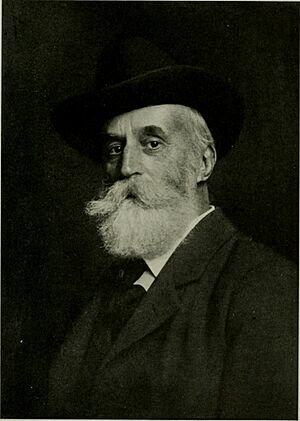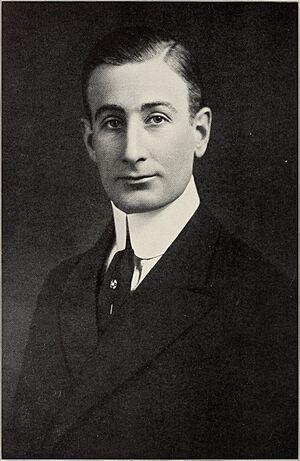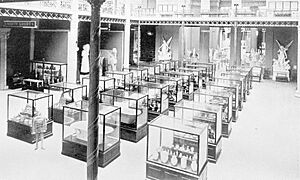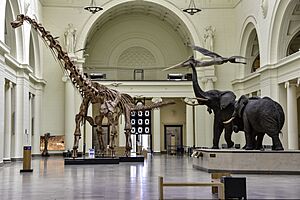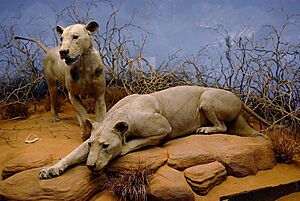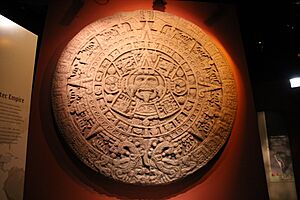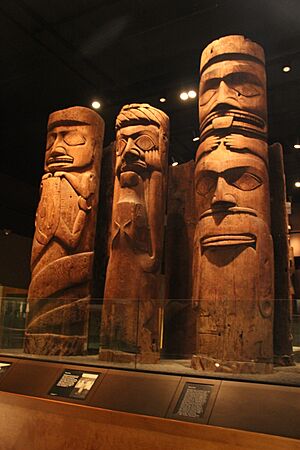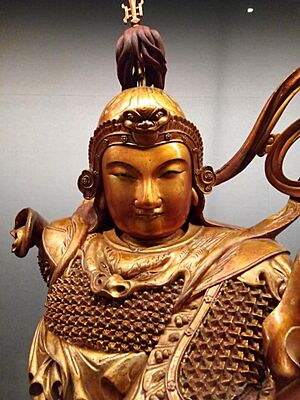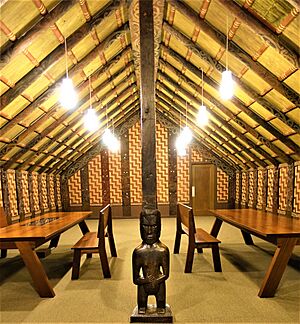Field Museum of Natural History facts for kids
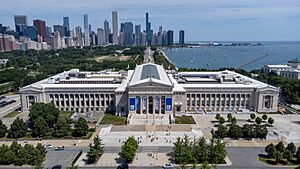
The Field Museum's south front
|
|
| Lua error in Module:Location_map at line 420: attempt to index field 'wikibase' (a nil value). | |
| Established | June 2, 1894 |
|---|---|
| Location | Near South Side, Chicago, Illinois, United States |
| Visitors | 1,018,000 (2022) |
| Public transit access | at Museum Campus/11th Street Red Orange Green |
The Field Museum of Natural History, often called The Field Museum, is a huge natural history museum in Chicago, Illinois. It's one of the biggest museums of its kind in the world!
This museum is famous for its amazing educational programs and scientific research. It has a massive collection of specimens and artifacts. You can see fossils, learn about different cultures from around the globe, and enjoy interactive programming. These programs teach visitors about important conservation needs today.
The museum is named after Marshall Field, a generous person who owned department stores. He was the museum's first big supporter. The museum started with items shown at the 1893 World's Columbian Exposition, a huge fair.
The Field Museum also has special temporary exhibits that change often. Its expert staff takes care of over 24 million specimens and objects. These items are used for the museum's scientific research. The collections include all kinds of biodiversity, gems, meteorites, fossils, and many anthropological items. These are cultural artifacts from all over the world.
The museum's library has over 275,000 books and journals. These focus on biology, evolution, geology, and archaeology. Scientists and staff at the museum go on field expeditions to study nature and cultures. They work on every continent, training students and looking after the collections. They also help create the public exhibits and educational programs.
Contents
- History of the Field Museum
- Visiting the Museum
- Amazing Permanent Exhibitions
- Animal Halls: Explore Wildlife
- Evolving Planet: Life Through Time
- Inside Ancient Egypt: A Journey to the Past
- The Ancient Americas: 13,000 Years of History
- Cultural Halls: Discover World Cultures
- Geology Halls: Earth's Treasures
- Underground Adventure: A Bug's-Eye View
- Working Laboratories: Science in Action
- Sue, the Tyrannosaurus rex
- Scientific Collections: A Treasure Trove for Research
- The Museum Library
- Learning and Research at the Museum
- Museum Publications
- See also
History of the Field Museum
The museum started collecting things even before it officially opened. In 1869, it got a huge collection of birds and their descriptions from Daniel Giraud Elliot. He was an artist and an expert on birds. Later, in 1894, Elliot became the head of the museum's Zoology Department. He worked there until 1906.
After the World’s Columbian Exposition in 1893, a man named Edward Ayer wanted to keep the fair's exhibits for future generations. He convinced Marshall Field to help pay for a new museum. It was first called the Columbian Museum of Chicago. This name honored its start at the World's Fair.
The museum officially opened on September 16, 1893. Its goal was to gather and share knowledge, and to save and show artifacts about art, archaeology, science, and history. The Columbian Museum was in the Palace of Fine Arts, the only building left from the fair in Jackson Park. Today, that building is the Chicago Museum of Science and Industry.
In 1905, the museum changed its name to Field Museum of Natural History. This was to honor Marshall Field, its main supporter. It also showed that the museum focused on natural sciences.
Stanley Field became the museum's president in 1906.
From 1943 to 1966, the museum was known as the Chicago Natural History Museum. In 1921, the museum moved to its current spot in downtown Chicago. By the late 1930s, the Field Museum was one of the top three museums in the United States. The other two were the American Museum of Natural History in New York City and the National Museum of Natural History in Washington, DC.
The museum has continued to grow and improve. It adds to its collections and does more scientific research. It also creates amazing exhibits, publications, and programs. The Field Museum is part of Chicago's Museum Campus. This campus also includes the John G. Shedd Aquarium and the Adler Planetarium.
Visiting the Museum
In 2022, over 1 million people visited the Field Museum. This made it one of the most visited museums in the United States.
Amazing Permanent Exhibitions
Animal Halls: Explore Wildlife
The Animal Halls let you see animals up close in their natural homes. Exhibits like Nature Walk, Mammals of Asia, and Mammals of Africa show how diverse animal habitats are. A very famous display features the man-eating lions of Tsavo. You can also see the Mfuwe man eating lion.
Evolving Planet: Life Through Time
Evolving Planet takes you on a journey through 4 billion years of life on Earth. You'll see fossils of tiny single-celled organisms, early animals, dinosaurs, and extinct mammals. The exhibit also shows early hominids, which are our ancient human relatives. The museum has a huge collection of non-mammalian synapsid fossils, including many rare ones.
Inside Ancient Egypt: A Journey to the Past
Inside Ancient Egypt gives you a peek into the lives of ancient Egyptians. You can see 23 real human mummies and many mummified animals. The exhibit has a three-story copy of a mastaba tomb. This replica includes two real rooms with 5,000-year-old hieroglyphs. These belonged to Unas-Ankh, the son of a pharaoh.
You can also explore an ancient marketplace with items from daily life. There's a special place for the cat goddess Bastet. Dioramas show how ancient Egyptians prepared for the afterlife. In 2024, the museum used CT scans to study 26 of its mummies.
The Ancient Americas: 13,000 Years of History
The Ancient Americas exhibit shows 13,000 years of human creativity in North and South America. Many different societies lived here long before Europeans arrived. This large exhibit tells the amazing story of how people came to these continents. It covers everything from the Arctic to the tip of South America.
The exhibit has six main parts: Ice Age Hunters, Innovative Hunters and Gatherers, Farming Villagers, Powerful Leaders, Rulers and Citizens, and Empire Builders. It's best to start with Ice Age Hunters and finish with Empire Builders. This way, you can see how cultures and economies changed over time. The items on display help you understand the cultures they came from.
This exhibit uses many items from the Field Museum's large North America collection. Important items include pre-Columbian artifacts from Mayan experts. Also, a big part of the "Farming Villagers" display comes from the American Southwest. The Empire Builders section has Aztec and Incan artifacts collected in the 1800s.
This exhibit connects to other halls, like the Alsdorf Hall of Northwest Coast and Arctic Peoples. It also leads to the Native Truths: Our Voices, Our Stories exhibit. This shows how all the museum's American collections are linked.
Cultural Halls: Discover World Cultures
The Cultural Halls let visitors explore different cultures from around the world. You can see traditional clothing from Tibet and China. There's also an exhibit about life in Africa, where you can learn about many different cultures. Another exhibit lets you "visit" several Pacific Islands.
The museum has a real 19th-century Māori Meeting House, called Ruatepupuke II. It comes from Tokomaru Bay, New Zealand. The museum's Northwest Coast Collections show early work with the Kwakwakaʼwakw (Kwakiutl) people. This is in the Alsdorf Hall of Northwest Coast and Arctic Peoples. Finally, the Native Truths: Our Voices, Our Stories exhibit shares the stories of North American Indigenous people.
Africa: A Continent of Cultures
The Africa cultural hall opened in November 1993. It has 14 different displays that focus on people and their ways of life. Several African countries and areas like the Sahara are shown. The collection mostly comes from the work of Wilfred D. Hambly.
Peoples of the Arctic and Pacific Northwest
This large exhibit covers two important culture areas: the Arctic and the Pacific Northwest. The Pacific Northwest collection is bigger. Both collections are divided into four parts: how people lived, their villages and societies, their spiritual beliefs, and their art. You can see many dioramas and a large collection of totem poles. This exhibit started from the Maritime Peoples hall, created by James VanStone.
Cyrus Tang Hall of China
The Cyrus Tang Hall of China opened in 2015. It has five sections: Diverse Landscapes, Ritual and Power, Shifting Power, Beliefs and Practices, and Crossing Boundaries. The first three sections are in order of time, and the last two are about different themes. Three hundred and fifty objects are on display. These are just a few from the museum's huge China collection. This collection was gathered by Berthold Laufer, an expert on China.
Native Truths: Our Voices, Our Stories
Native Truths: Our Voices, Our Stories opened in 2021. This exhibit is a big update of the old Native American Hall. Native Truths uses about 400 artifacts to explain Native American culture and history. It also talks about challenges they face today. This exhibit shows a new way of thinking about Native Americans, focusing on their voices and stories instead of just their artifacts.
Regenstein Halls of the Pacific
This exhibit explores the nature and cultures of the Pacific Islands. It has five sections: the islands' natural history, how Pacific Islanders' cultures began, a display of canoes, items from New Guinea's Huon Gulf, and a modern Tahitian market. The last part shows the ceremonial art of Pacific peoples. Most of the collection was gathered by Albert Buell Lewis. The exhibit shows how Pacific Islands connect with the world today.
Geology Halls: Earth's Treasures
The Grainger Hall of Gems has a huge collection of diamonds and other gems from all over the world. It also features a beautiful stained glass window by Louis Comfort Tiffany. The Hall of Jades focuses on Chinese jade artifacts that are up to 8,000 years old. The Robert A. Pritzker Center for Meteoritics and Polar Studies has a large collection of fossil meteorites.
Underground Adventure: A Bug's-Eye View
The Underground Adventure lets you see the world from a bug's point of view! You can discover what insects and soil look like when you're tiny. You'll also learn about all the different living things in soil and why healthy soil is so important.
Working Laboratories: Science in Action
- DNA Discovery Center – You can watch real scientists take DNA from different living things. You can also talk to a scientist through the glass every day and ask questions about DNA.
- McDonald's Fossil Prep Lab – You can watch paleontologists (fossil experts) get real fossils ready for study.
- The Regenstein Pacific Conservation Laboratory – This is a big lab where conservators work to protect and study old items from around the world. You can watch them at work.
Sue, the Tyrannosaurus rex
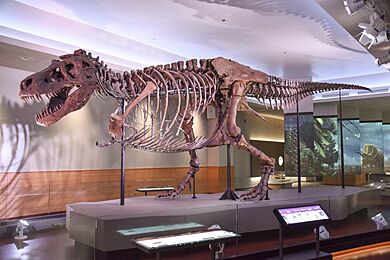
On May 17, 2000, the Field Museum showed off Sue. Sue was the biggest T. rex skeleton found at that time. Sue is about 40.5 feet long and stands 13 feet tall at the hips. Scientists think Sue weighed between 8.4 and 14 tons. This fossil is estimated to be 67 million years old.
The fossil was named after Sue Hendrickson, the person who discovered it. People often call Sue "she," but we don't actually know if the dinosaur was male or female. The real skull is not on the body because it's hard to study it so high up. Also, a lighter replica looks better on the skeleton.
Scientists studied Sue's bones and found that the dinosaur died at age 28. This was a record for a T. rex fossil until another one, Trix, was found in 2013. In December 2018, Sue's skeleton was moved to a new area in The Griffin Halls of Evolving Planet. This was after some updates were made to show new ideas about how Sue's body looked.
Scientific Collections: A Treasure Trove for Research
The Field Museum's collections are carefully managed by experts. They are a huge resource for scientists all over the world. These collections help researchers track environmental changes and learn about biodiversity. They also help with taxonomy (naming and classifying living things) and systematics (studying how living things are related). Many of the Field Museum's collections are among the top ten in the world. For example, its bird skin collection is the fourth largest, and its mollusk collection is one of the five largest in North America.
The museum's scientific collections started with items gathered for the World Columbian Exposition between 1891 and 1893. From the very beginning, the Field Museum had a large collection of items about human cultures.
Many early natural history specimens were bought from Ward's Natural History Establishment. The museum also started a big program to get more items, including many expeditions by its staff. In the first 50 years, the Field Museum sent over 440 expeditions to collect specimens from all over the world.
Other items were added by buying them, like H. N. Patterson's plant collection in 1900. The Strecker butterfly collection was bought in 1908.
Many specimens and artifacts were given to the museum by collectors and donors. For example, the Boone collection has over 3,500 East Asian items, including books and prints. The museum also takes in "orphaned collections" from other places, like universities that no longer focus on collections-based research. For instance, starting in 1907, the Field Museum accepted many plant collections from universities into its plant collection (herbarium). These items are kept safe and are always available for researchers worldwide.
Today, collecting specimens and getting artifacts follows clear rules. The goal is to only get items where we know exactly where they came from. All biological specimens are collected with the right permits. Often, specimens are returned to their home country after they are studied. The Field Museum is a leader in creating these ethical standards. It was one of the first museums to return cultural and archaeological artifacts to their original communities.
Caring for Collections
Field Museum collections are managed by experts who know how to prepare and preserve items. Many new ways to care for collections were developed at the Field Museum. For example, Carl Akeley created excellent taxidermy methods. This made the first natural-looking mammal and bird specimens for exhibits and study. Museum experts also created standards for how to best care for collections.
Conservators at the Field Museum have helped science by finding new ways to preserve artifacts. This includes using special traps to control moths that can damage items. The museum also uses special display cases to control humidity and protect items from rust. They have found ways to dye Japanese papers to match old repairs. They also test collections for old heavy metal pesticides and study how early plastics and sulfur can affect items.
As science grows, new types of collections are added, like frozen tissue collections. These need new ways of collecting and preserving them.
Collection Records: Keeping Track
Managing collections means keeping very careful records. In the past, handwritten books were used to record information about specimens and artifacts. The Field Museum was one of the first to use computers for collection data in the late 1970s.
The Field Museum shares its digital collection data with many online groups. This includes Global Biodiversity Information Facility (GBif) and others. All the museum's collection databases are now in one system called KE EMu software. Digital specimen data and georeferenced location data are very important for research. They help scientists study how things change due to climate or land use.
Using the Collections
During the World's Columbian Exposition, all the collected items were on display. The fair was all about showing these materials. For example, when the Columbian Museum of Chicago first opened, the mollusk collection filled an entire hall. It showed 3,000 types of mollusks. By 1910, 20,000 shell specimens were on display, with another 15,000 stored away.
Only a small part of the specimens and artifacts are shown to the public. Most of them are used by many people inside and outside the museum. Field Museum scientists and their students use the collections for their research and training. Researchers from all over the world can search online for specific specimens. They can ask to borrow them, and the museum ships them out carefully. This ensures the specimens stay in good condition. For example, in 2012, the museum's Zoology collection sent over 42,000 specimens to researchers.
These collection specimens are a key part of research. Each specimen can be looked at again and again. With new scientific tools, new information can be found from items collected over 150 years ago.
The Museum Library
The library at the Field Museum started in 1893. It helps the museum's scientists, visiting researchers, students, and the public. It's a resource for research, creating exhibits, and educational programs. The main collection has 275,000 books. These focus on biology, evolution, anthropology, botany, geology, archaeology, and museum studies.
Ayer Collection
This is a private collection from Edward E. Ayer, the museum's first president. It has almost all the important books about the history of ornithology (the study of birds). It's especially rich in books with colorful pictures.
Laufer Collection
This collection belonged to Dr. Berthold Laufer, America's first expert on China. He was the Curator of Anthropology until he passed away in 1934. It has about 7,000 books in Chinese, Japanese, Tibetan, and Western languages. These books cover anthropology, archaeology, religion, science, and travel.
Photo Archives
The photo archives have over 250,000 images. These photos cover anthropology, botany, geology, and zoology. They also show the museum's history, buildings, exhibits, staff, and scientific trips. In 2008, some photos from the archives became available online. These included pictures from the 1893 World's Columbian Exposition and Illinois landscapes. In April 2009, the Photo Archives joined Flickr Commons.
Karl P. Schmidt Memorial Herpetological Library
This research library is named after Karl Patterson Schmidt. It has over 2,000 books about herpetology (the study of reptiles and amphibians) and many articles.
John James Audubon's Birds of North America
The Field Museum has a special large copy of Audubon's The Birds of America. It's one of only two known copies arranged by animal groups. It also has all 13 special plates. The museum's copy belonged to Audubon's family doctor.
Learning and Research at the Museum
The Field Museum offers many ways to learn. Exhibits are the main way to learn informally. But the museum has also created new educational programs throughout its history. For example, the Harris Loan Program started in 1912. It sends artifacts, specimens, videos, and activity kits to children in Chicago schools. The Department of Education, started in 1922, offers classes, talks, field trips, and special events for families and children. The Field Museum also helps produce the YouTube channel The Brain Scoop. They hired the host, Emily Graslie, full-time as their 'Chief Curiosity Correspondent'.
The museum's scientists in Anthropology, Botany, Geology, and Zoology do basic research. They study how living things are related and human cultures. They also manage the collections and help with educational programs. The museum works closely with the University of Chicago and the University of Illinois at Chicago. They share teaching, students, and seminars. The museum also holds scientific meetings and lectures, like the annual A. Watson Armour III Spring Symposium. These events share scientific discoveries with scientists and the public.
Museum Publications
The museum used to publish four scientific book series called Fieldiana. These books were about anthropology, botany, geology, and zoology. They were reviewed by other experts before being published.
See also
 In Spanish: Museo Field de Historia Natural para niños
In Spanish: Museo Field de Historia Natural para niños
- Chicago Brachiosaurus replicas
- List of most-visited museums in the United States
- List of museums and cultural institutions in Chicago


